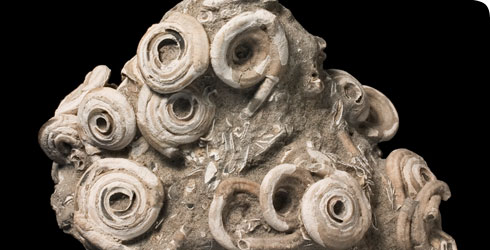Cyclical fossil record research
The diversity of marine organisms over geological time is recorded in the fossil record found in rocks. Changes in this diversity have been found to occur in a cycle of 62 million years where periods of high diversity cycle with periods of very low diversity.
Research by Museum scientists suggests these regular changes may not be due to cycles of 'boom and bust' in diversity but are largely explained by the nature of the rock record. The more rock preserved from a particular age, the more fossils found.
Boom and bust
In 2005, in the journal Nature, scientists Rohde and Muller identified a 62-million-year 'boom and bust' cycle in genus-level diversity of marine organisms in the fossil record. Numbers of recorded fossils were shown to swing from low to high and back again repeatedly over the past 542 million years - the period of time known as the Phanerozoic eon.
Cycles of diversity
Explanations for these patterns and the apparent cycles of diversification and extinction have been hard to find. Scientists have looked at many different processes that might explain these cycles, including volcanic activity, comet impacts and sea level and climate change. None, however, show a matching cyclicity. Although sea level changes were considered, Rohde and Muller did not measure them in a way that incorporated geologists' understanding of how changes in sea level affect the preservation of fossils in the geological record.
New research findings
Research by palaeontologists Andrew Smith and Alistair McGowan from the Natural History Museum, strongly suggests that much of the variation in marine diversity is not connected to biological factors, but is caused by differences in the amount of rock available for sampling the fossils.
'The observed diversity of marine organisms is systematically higher when there is more rock preserved for geologists and palaeontologists to study,' says McGowan. 'Differences in the erosion and deposition of marine sediments, and the range of habitats they sample, could be as important for generating the apparent "boom and bust" patterns in marine biodiversity'.
Specimen collections
When researchers collect diversity data from an area, they have to find, identify and record each specimen. We know from studies of 'collector curves' that the more time and the more people working on an area, the nearer our estimates of diversity will be to the actual value. For example, our current best estimate for the number of bird species in the British Isles is probably close to the true diversity, because there are many birdwatchers that have now kept records for hundreds of years. New bird species, to science (indigenous people often know about them), are still being found in the Amazon.
Problems in preserving fossils
An added problem for palaeontologists is that of preservation of the fossils. Some organisms, such as worms, do not have many hard parts, so are unlikely to be preserved. Only exceptional deposits, such as the Burgess Shale in Canada, preserve soft-bodied organisms. This problem is well understood, and marine diversity studies in the fossil record tend to focus on organisms with hard parts, such as snails and bivalves.
Sedimentation and erosion
Different organisms live on different parts of the seabed, and these different areas are not all evenly represented in the geological record. As sea level cycles up and down, the chances of preserving sediments from these different environments changes. If very diverse habitats existed, but no sedimentary record of those environments survived in the fossil record, there will be no fossils, lowering our estimate of diversity. This chance of preserving sediments is a function of both laying down sediments in the first place, and then these sediments not being destroyed during episodes of sea level fall, when a lot of erosion takes place.
High sea levels
During periods of rising sea level we tend to preserve (and thus can sample from) a wider range of habitats, and being able to sample more habitats leads to a higher diversity. An example in the modern world is if we based our estimate of how many bird species there are in the whole world on the British Isles. In this case, we would be sampling from a limited range of not very diverse habitats. Our estimate would be too low.
McGowan adds, 'As in the above example, we have to try to ensure we understand whether our samples are based on samples from the whole range of marine habitats, or from a more limited range of environments. Based on statistical analyses, around about half of the change in diversity can be attributed to changes in the rock record. The other half could be genuine biological effects.'
An analogy would be to look at the variations in height in people. Genetics and nutrition both play a role - genetics is a background variable we cannot change, leaving a proportion of the variation being the result of differences in nutrition.
The research paper is from Biology Letters and a summary is published in the 23 July 2005 issue of the New Scientist magazine.
Toolbox

In 2003 nearly 12,000 scientists from over 60 countries came to work at the Museum.

